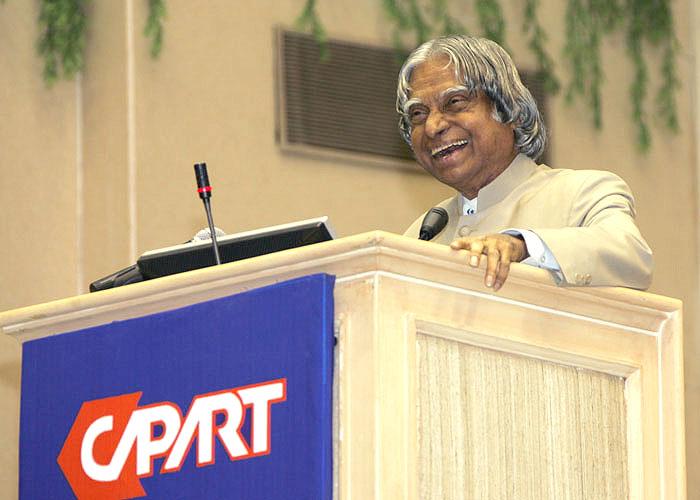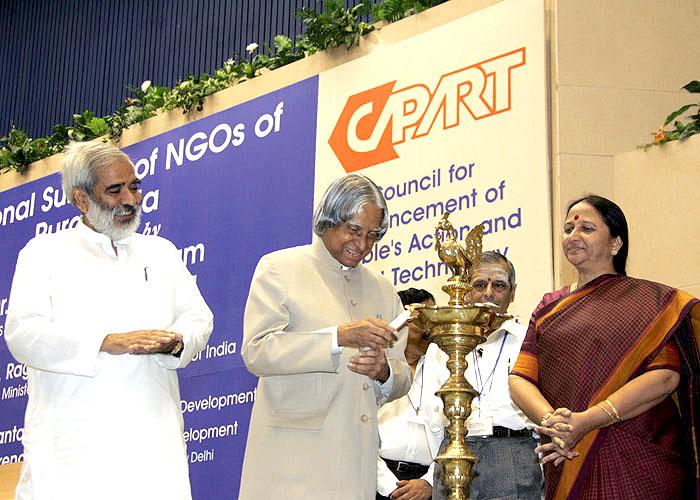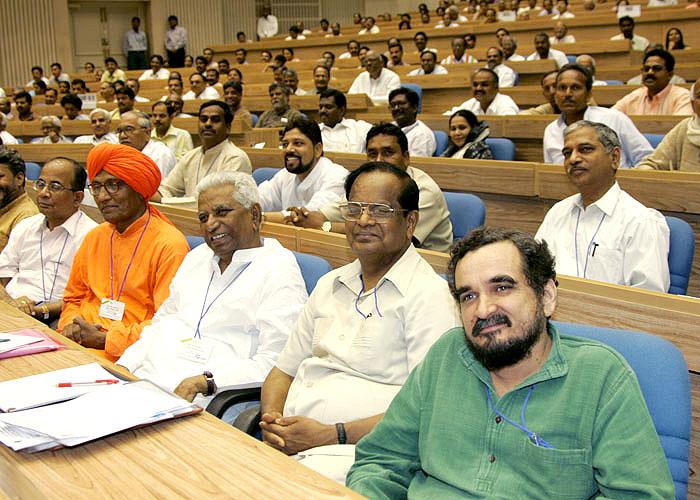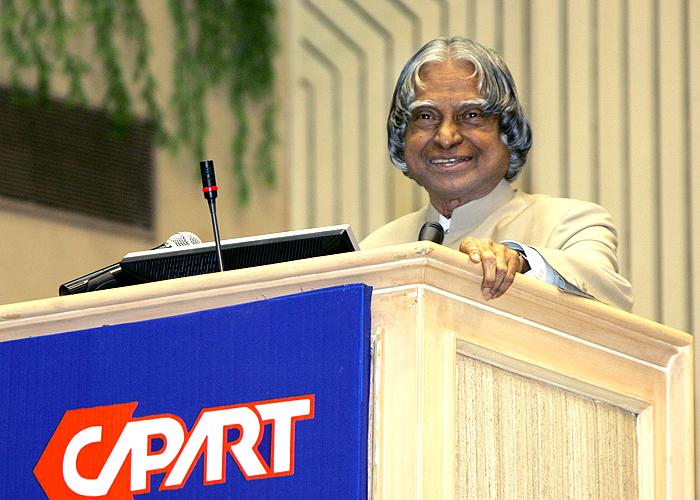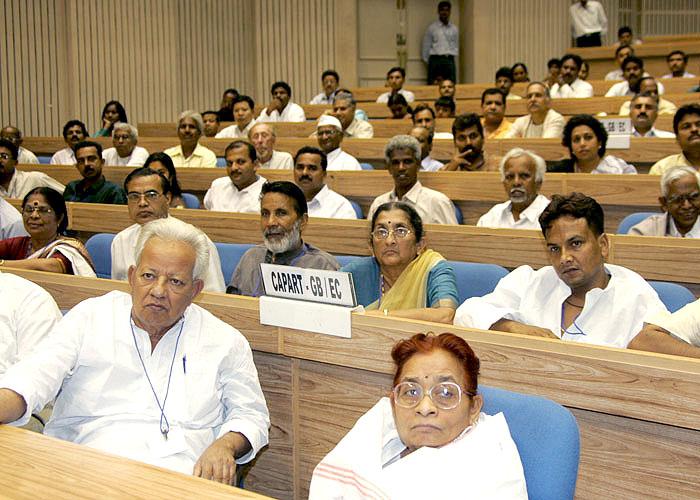Address at the Inauguration of the National Summit of Rural Ngos of India
New Delhi : 25-04-2005
Employment Generation is the Foundation for Rural Development
I am indeed delighted to participate in the Inauguration of the National Summit of Rural NGOs of India being organized by the Council for the Advancement of Peoples? Action and Rural Technology (CAPART) of the Ministry of Rural Development. I am happy to deliver the inaugural address. I extend my greetings to the members of the rural NGOs, members of the Confederation of the NGOs of Rural India, the functionaries of the Ministry of Rural Development and distinguished guests. Integrating the work of large number of NGOs spread in different parts of the country is definitely an important event. This action will have to lead to the integrated development of our village clusters based on the core-competence of the region through the catalytic influence of the participating NGOs. I would like to talk to this gathering on the topic "Employment Generation is the Foundation for Rural Development".
Rural Prosperity
As you are all aware, nearly 700 million people of India live in the rural areas in 600,000 villages comprising of 200,000 Panchayats. Connectivity of village complexes providing economic opportunities to all segments of people is an urgent need to bridge the rural-urban divide, generate employment and enhance rural prosperity. Repeating what we are doing for several decades with more of the same, may not be the way to proceed further. We need innovation and transparent performance in our action.
Rashtrapati Bhavan experience
We had certain acres of unutilized land in the Rashtrapati Bhavan. We were discussing how to use this land. Through a brain storming session, we found that we had two options, either we could use it as an extended flower garden or make it people centric through the other beneficial plantations. Since Rashtrapati Bhavan is the first home of the country, we thought, it will be more appropriate to use the land for certain societal missions.
We created two herbal farms. One farm was used for assisting the farmers on how to add value to their products by selecting good quality herbs, how to extract, how to store and how to market the product. This will be done in partnership with National R & D Laboratories. Second one, we created for use by the visually challenged people, where they could feel the plant, smell the plant and learn about various plants through the Braille boards.
Simultaneously, we created a spiritual garden. Here we planted very important plants which are valued by people of various religions. This will create Unity of Minds among people of different faiths since all the plantations were in a cluster. In the third area, a nutritional garden has been created where the vegetables and fruits are grown using organic cultivation. In the fourth area we cultivated Jatropha curcus, the bio-fuel plant; so that farmers can learn about the Jatropha cultivation and the conversion of Jatropha into Bio-fuel which can substantially increase the earning capacity of the farmers. After 9 months to a year, Rashtrapati Bhavan is able to offer something to the farmers, something to the visually challenged people, something to the students, something to the people of different religious faith and spiritual personalities apart from the lovers of beautiful flowers.
Rashtrapati Bhavan was receiving nearly two lakh visitors a year in the earlier years. Now Rashtrapati Bhavan receives over one million people in a year with varied interests. Some of them are interested in seeing the beauty of the garden, some farmers would like to learn about important herbal cultivation and Jatropha plantations, some life science students would like to know more about plants and plants characteristics, religious personalities would like to see spiritual garden and the visually challenged people would like to have first hand feel of the herbal garden. The increase of citizen?s visit by five times occurred due to the citizen centric nature of the Rashtrapati Bhavan garden.
What one should be remembered for?
I generally assume that most of the NGOs, have a purpose in life and would like to contribute to the welfare of the society. The motto of the NGO can be "what I should be remembered for."
One study on the contribution of NGO reveals that the certain amount of funds from foreign contributors and grants-in-aid from various departments are being deployed on a yearly basis. However the impact of this investment is not reaching the grass root level in the villages to the expected degree. The study indicates that large contributions of societal work of NGOs are visible in certain southern States and Maharashtra. I would request the NGOs and rural development agencies such as CAPART to assist Bihar, UP and North Eastern States and show their societal spirit, their entrepreneurial spirit, mission oriented approach and assist in rural transformation. Life has offered us an excellent opportunity. There is no great challenge in treading the well laid out path. Rural NGOs have to create a new path. What are the new paths?
The New Paths
Let us imagine that it has rained for over two hours in a village area. During the rain we observe many streams. Whether the water in the streams reach the local lake and ponds and stores the water for the villagers to use in subsequent period, or it goes to the sea or gets dried up on the way, is dependent on the contour which has been made in the village and the obstruction-less path created by the Village Panchayat for the flow of water. In some places, the roads are kept at a higher level so that the captured water in the road directly flows into the nearby water bodies. This I have seen this in the Mount Abu area. I had the opportunity to see the progress of works being done by the NGO?s in different places. In many places the flow of benefits of the scheme comes to a grinding halt as soon as the NGOs or the Government functionaries leave the scene. Hence we have to ensure that a sustainable mechanism has to be created for continuous functioning of the scheme, even if the NGO or government agency leaves the place. How? This should be done by training the local people, so that they can manage the scheme and make the benefits flow to the villagers. Rural Development Ministry must make the Panchayats and the District Authorities accountable for the sustainable functioning of the scheme. Normally, the short of maintenance leads to non-operation of many good development works. These maintenance areas can be given to the ex-servicemen after certain amount of training, since this disciplined force are spread in all parts of the country. It is very essential in all our development work.
Employment Generation missions
PURA (Providing Urban amenities in Rural Areas) envisages the employment generation is the Foundation for sustainable Rural Development. The integrated methods which will bring prosperity to rural India are: the physical connectivity of the village clusters through quality roads and transport; electronic connectivity through tele-communication with high bandwidth fiber optic cables reaching the rural areas from urban cities and through internet kiosks; knowledge connectivity through education, skill training for farmers, artisans and craftsmen and entrepreneurship programmes. These three connectives will lead to economic connectivity through starting of enterprises with the help of banks, micro credits and marketing of the products.
No development work is sustainable or complete unless employment potential is created. Some of the productive employment generation schemes are bio-fuel production, waste land development, water harvesting, bamboo mission, converting fly ash into wealth, cotton cultivation to garment manufacture, healthcare and village knowledge centre. The details of these schemes I have discussed in my Republic day address to the nation. Whatever benefits are created in education, healthcare or other welfare schemes, they are scantly utilized, unless the rural people have a potential to earn.
In the budget estimates for the year 2005-06 certain provisions has been made for generation of PURAs with a scope of integrated village development. The integrated method envisages a mission mode empowered management structure with executive powers at the local implementation levels and by reducing the transactional costs through simplification of procedures of governance.
Cost of creating such clusters depending upon the region and population will vary and will be between Rs.50-100 crores per cluster. After initial short-term employment during construction etc., we have to plan for initiating actions for providing regular employment opportunities for five thousand people of a village cluster with a population of twenty five thousand. This has to be done by creating new market driven enterprises based on the employment generation avenues which I have mentioned to you earlier by promoting entrepreneurship in the rural areas and equipping people with skills for their own self-employment for meeting the needs of economy and society.
Now I would like to discuss how to empower the villages governed by Panchayats with reference to some of the successful rural development models on the lines of PURA.
Periyar PURA (Providing Urban Amenities in Rural Areas)
Knowledge radiate from women engineering college. Periyar PURA has a ring road and interconnecting roads covering major villages along with bus transport system. They have provided Internet kiosks through wireless connectivity for many of the villages. Periyar Maniammai hospitals and family welfare centres along with the mobile cancer diagnostic clinic provides health care to the population of the rural complex. Campus provides education from Kindergarten to Post graduation. In addition, they are providing knowledge connectivity through awareness and training programmes for use of organic manure (vermi compost), Yoga and Siddha-based formulations, renewable energy, rainwater harvesting and general health. Women are empowered through Self-Help Groups, entrepreneurship development programmes including training programmes for skill development and micro business activities. Organizers of Periyar PURA have established so far 525 self-reliant Self Help Groups, which provide employment for 8000 rural women through products for which technologies have been transferred apart from other employment generation from support services. They are self-sufficient in energy through solar power and biomass gasifier plants. Towards economic development they have integrated farms, energy plantation, aquaculture, livestock farms and dry land horticulture. They have innovative water management schemes for irrigation. Provision of training to the village community in printing technologies, refrigeration & air conditioning, hardware training, Desk Top Publishing (DTP), plumbing, electrical wiring, welding/fabrication, bakery and construction technology has created job opportunities to the villagers. The members of the villages are fruitfully employed and they are producing value added products. A transformation has taken place keeping our civilizational heritage intact and converted the rural settings into a livable habitat. I have witnessed the progress of this project.
The message I would like to convey through this model is how an engineering college for women with a vision can transform sixty five villages with a population of three lakhs. They have the passion to transform the lives of the village around them as they thought differently and acted differently. That is how they enriched the society all around. Let me narrate another example in from South Gujarat.
Bharatiya Agro Industries Foundation (BAIF) Model for Tribal Rehabilitation and Dry Regions
I would like to share with you an integrated village cluster development programme which I witnessed during my visit with Dr. Narayan G Hegde, an IIM graduate who is an expert in farming and Dairying, two village clusters of south Gujarat - Chonda and Lachakadi, with a population of 5000. In these villages every summer the tribal people migrate to nearby towns. The BAIF model was installed in these two villages with peoples? co-operation and the participation of state authorities. Firstly water harvesting was undertaken to get water for every individual. Every home was provided with livestock and also a market for milk. Simultaneously, fruit orchards were established with various fruit crops such as cashew and mangoes, which are tolerant to drought. When I visited, these villages, there was a connecting road and water ponds. The tribal population, with radiant smiles on their faces, was harvesting crops, packaging and carrying milk to different supply points. I happened to see the economic growth and prosperity of the tribal people, which has been facilitated by BAIF with people?s participation. I understand that this model ? Vadi (Orchard) has now been replicated in many places by the state governments of Maharashtra, Gujarat and Rajasthan.
The project was implemented through Self Help Groups (SHGs) by building mutual confidence. The groups took the responsibility to help the weaker members. This boosted progress. The results were phenomenal. In Ghatol cluster in Udaipur out of 3000 poor families, more than 90% were able to earn Rs. 20,000 per annum. Efficient watershed development not only helped to ensure the availability of safe drinking water throughout the year but also boosted their crop yields from 30% to 80%. Over 800 hectares of Anola orchards were established for the first time in the region, which started yielding from the third year. The farmers groups have started processing and marketing the fruits. The entire village cluster was self-sufficient in food supply. Dairy and animal husbandry further boosted their family income from 30 to 60%. These families had formed 71 Self Help Groups and 24 village level organizations. They have built their own corpus of Rs. 30 lakhs. Similar success was achieved in Banswada district. In Gokulpura cluster in Bundi district in Rajasthan, watershed based multi-disciplinary development facilitated the local farmers to grow two crops during the year while the entire district was receiving food aid under the drought relief. This happened in a region where the average annual rainfall is less than 700 mm and the region was facing chronic drought successively for the third year.
These two examples demonstrate how the Periyar PURA and BAIF can bring prosperity to a village or a group of villages through concerted action to meet the needs of the village community. These are independent examples of "PURA in action". Now I would like to specifically elaborate on Village Knowledge Centre, which has got potential of providing real time communication to the rural people and the employment potential.
Village Knowledge Centre
With the kind of awareness and opportunities available in ICT, it will soon become a reality wherein every one of our villages will have computers and connectivity available. These would be the window to the world of knowledge for our villages and also to reap the benefits of our e-governance, tele-education, tele-medicine, e-commerce and e-judiciary initiatives. In spite of the all pervasive nature of the computers they would still be far away from being a truly friendly access device for our villagers. We would need in such cases, a human intermediary who would act as the village information officer. He will be the extended eyes and ears of the villager to the world of knowledge. India has approximately 2.3 lakh Village Panchayats. I visualize establishment of village knowledge centers in these Panchayats to empower the villagers with the knowledge and to act as a nodal center for knowledge connectivity for the villagers. The knowledge center will provide to the villagers the real time information about the market details on their products from the agriculture, cottage industry, fisheries and other rural industries in their locality as well as national markets. This also will provide direct quality employment to over one million people who will be instrumental in promoting higher level of wealth generation in our rural sector. In addition, Village Information Officer will become a vital link between the rural clusters and the NGOs and the other government agencies operating on development tasks in the clusters.
Now I would like to discuss how the members of different NGOs can work together and make our rural area prosperous, happy, and peaceful and a safe place to live for the two hundred and sixty million people who are living below the poverty line.
The mission of NGO
The study of nearly 12,300 NGOs profile spread in different parts of the country indicates that they are engaged in tasks such as rural housing, rural sanitation, watershed development, irrigation and drinking water, organic farming, agriculture products improvement etc. Also, I find that the funding for the NGOs is coming from multiple ministries and departments such as Health and Family Welfare, Rural Development, Human Resource Development etc. The average total funding from various ministries and departments during any financial year to the NGOs works out to the order of Rs. 500 crore. In addition, NGOs receive foreign contributions to an extent of Rs. 4000 crore. I was thinking how this large network of committed institutions can be used for rural development at a faster rate. Since the representatives of nearly two thousand five hundred NGOs have assembled here, I would like to share some of the thoughts on how NGOs can be a partner in the rural development with government agencies. Firstly, NGOs must be ready to find new paths of development instead of following the already repeated path. Secondly, the NGOs or the Government agencies when they leave the scene of development; the development initiated has to be made self-supporting and maintaining. Thirdly, there will be a tendency to take up development in relatively developed states or closer to the urban areas. They are not real challenges. It is more challenging to work in the States such as Bihar, Eastern UP and North-eastern States who are having the crying need for development.
Conclusion
In summary, I am having 12 suggestions for the Ministry of Rural Development and its government agencies and also their partners like NGOs for the integrated rural development of the country.
1. Rural development through PURA mechanism will lead to minimum cost and minimum time in execution of the rural development missions.
2. A master plan is essential for development of rural cluster complexes. Ministry of Rural Development can work out the number of PURAs in each of the districts in consultation with the respective states, districts administration and local bodies. And also they can prepare the master plan for individual PURA. NGOs can help in initial identification and preparation of master plan.
3. Ministry of Rural Development can facilitate the preparation of business plans for each of the PURAs through government, non-government and corporate agencies.
4. Ministry of Rural Development has to arrange fast funding methodology and time bound action by the executive agency. For enabling this, I would recommend institution of a two-tier management system and identifying a Programme Director. At the apex level an empowered Rural Development Board with participation by all executive agencies has to be created with delegated administrative and financial powers to the Programme Directors. At the next level there can be a project management board with representatives drawn from Panchayats, district agencies, NGOs and other supporting ministries and departments.
5. An management plan has to be evolved and approved the management boards (Stated in Para 4)
6. The government grants required for development work to be executed by NGOs may be approved on the recommendations of the empowered boards by the respective ministries to avoid duplication and ensuring integrated development of PURA complexes.
7. Empowered boards should encourage NGOs to execute the task in the village cluster through the local talents to the maximum extent possible so that the development tasks become the income as well as employment generation avenue for the rural people till rural enterprises become operational.
8. It is essential to prepare a database of all successful rural development tasks achieved in the country and sustained. I would like to share some of them. Periyar Pura, BAIF Experience, Enhancement of seed cotton productivity in Nava Pind village in Punjab, successful provision of internal roads in Kuthampakkam by villagers (near Chennai) themselves and Siruthuli in Coimbatore. Members assembled here may have many such examples which can be consolidated. This directory can be the guiding post.
9. Rural Development is a very important mission. The fund allotted to various agencies like Government, NGOs have to properly used for the mission and accounted, the results should be seen by the people. A transparent management and performance system is essential.
10. For ensuring continuity of development, the Ministry of Rural Development should have a fixed tenure of five years to all the functionaries of the empowered management system. This will bring a system of accountability among the functionaries, leading to the realization of prosperous rural clusters in a time bound manner. Change of government or change of personalities should not disrupt developmental programmes.
11. I have a suggestion. The name NGO does not sound well. They can be called as Societal Transformers or any other name you all can consider.
12. Based on the NGOs ? Rural Development Agency (CAPART) performance and results, the total budget can be enhanced to Rs. 10,000 crore including contribution from other countries.
I inaugurate the National Summit of Rural NGOs of India. I wish all of you, the Government functionaries? and NGOs success in their mission of making our rural clusters prosperous, happy and a peaceful place for the village citizens to live in. Our dream has to be to realize reverse migration of people from urban area to rural area.
May God bless you.

